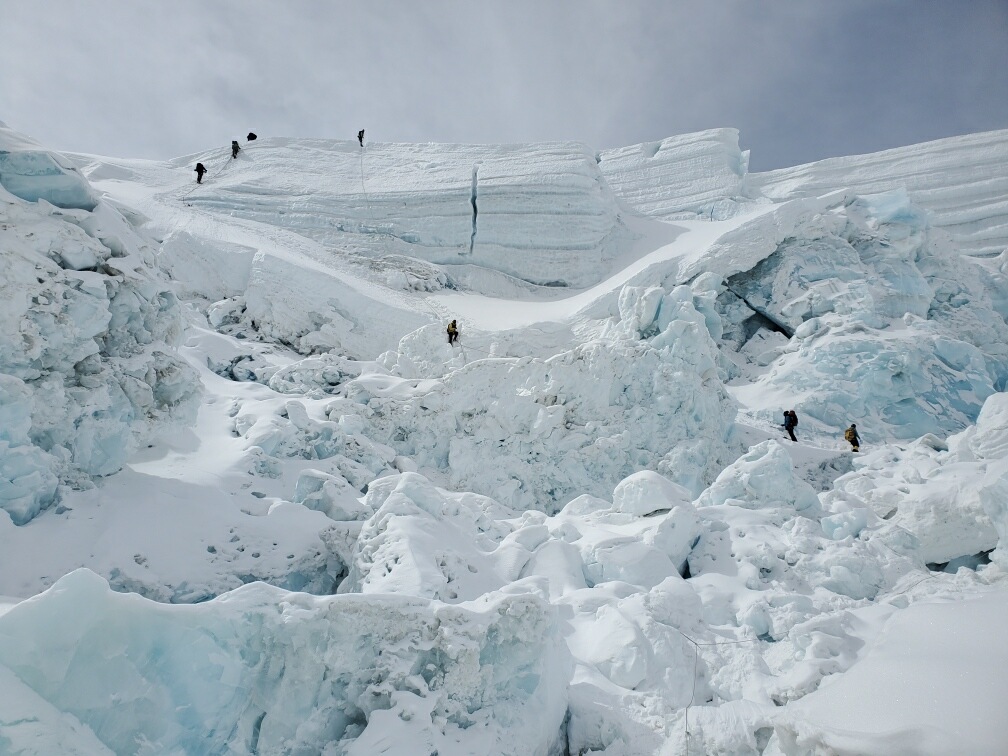Some information may be outdated.
Jason Ramsdell and Matthew Fleishman describe their Everest attempt
The evening of May 16, Jason Ramsdell had just crawled into his sleeping bag at Camp Four at the South Col on Mt. Everest. He’d had a long day—he had woken up at 6 a.m. at Camp Three, then climbed for 12 hours—and a long week, making the trek from Base Camp (17,598 feet) to Camp Four (25,938) where his team would go for the summit.
But then, a head popped into where Ramsdell was sleeping: his Sherpa guide, telling him to put his big boots on.
“We hadn’t slept at all, and now we’re launching for the summit,” Ramsdell said.

Ramsdell had been dreaming of Everest for years, he said. When he began training for his Everest expedition by hiking trails around Moab in the spring, he bumped into Matthew Fleishman, another Moab local, also training for an Everest expedition. The two men figured out that not only were they going to Everest at the same time, but that they were also going with the exact same guide company.
The men left in April, with an expectation they’d be back home by June. Everest is a monster of a mountain: it takes two weeks to trek just to Base Camp. Ramsdell said he enjoyed the Base Camp hike—his wife came with him, and the team had time to stay in teahouses and enjoy the scenery of the Himalayas. Fleishman said he thought the initial trek was a litmus test “of who would live or die.”
Once they reached Base Camp, it was time to think about climbing the nearly 12,000 more feet of elevation to reach the summit at 29,032 feet.
Ramsdell and Fleishman’s expedition did this by first putting everyone through acclimation trips: they climbed up a nearby peak, then up to Camp One and back through the Khumbu Icefall, which Ramsdell described as beautiful, but challenging. When the team reached Camp Two, there was a chance they could summit on May 3—but weather rolled in, forcing the team to return back to Base Camp and wait. That, both men agreed, was one of the most brutal aspects of the expedition.
“That was really mentally tough,” Ramsdell said. “And in general, I thought the climb was a really difficult mental game—I didn’t expect that as much. Certainly it’s physically challenging, but it’s also very mentally draining.”
To stay in shape, the Ramsdell and Fleishman did mini-acclimation trips: this was one of Ramsdell’s favorite memories, he said, and he enjoyed getting to know Fleishman better.

After days of waiting, another weather window opened up. The team would have a chance to summit on May 17.
Everest takes a nearly five-day push to the summit. The team hiked from Base Camp to Camp Two, then stayed two nights. They pushed to Camp Three and spent the night. They pushed to Camp Four, a twelve-hour journey, the following day, expecting to sleep before summiting.
But the guides had different plans. They were likely trying to avoid traffic jams, Ramsdell said—in 2019, a photo by Nirmal Purja, a Nepali mountaineer, showing a traffic jam of climbers attempting to summit Everest went viral, sparking debate over how many people should be allowed to summit Everest, if anyone at all.
Once Ramsdell and Fleishman had their boots on, the expedition quickly went awry.
“I have nothing good to tell you,” Fleishman said. “It was absolute murder and cutthroat up there. It was every man for himself.”


Fleishman described chaos at Camp Four: incidents of other climbers stealing oxygen bottles, climbers unsure of how to use essential equipment, thousands of climbers on the same rope leading up to the summit. According to Reuters, in April, Nepal issued a record 463 Everest permits (at $11,000 each) to climbers attempting the summit between March and May. By June, the BBC reported, 12 people had died on the mountain, making 2023 one of the deadliest Everest years in history.
Fleishman decided to not pursue the summit: he was exhausted and dehydrated from days of climbing. He had made his own summit: by reaching Camp Four, the South Col, at around 26,000 feet, he set a new personal altitude record.
“I wasn’t going,” he said. “I wasn’t dying over anything.”
Ramsdell decided to pursue the summit, reaching the peak by 10 a.m. on May 17. By then, he had been awake for over 24 hours: the sunset was beautiful, he said, but hard to appreciate through his haze of exhaustion. By the time he got all the way back to Camp Four, he had been awake, and climbing, for 36 hours.
The trek back down the mountain was one of the most challenging aspects of the trip—but that, he teased, he and Fleishman will discuss further during a presentation about their expedition on August 2 at 7 p.m. at the Grand County Public Library.
“It was extremely challenging,” Ramsdell said. “You just have to go, go, go every day, 10- or 12-hour days with very little breaks. You don’t drink much water. You don’t eat much … You know, I’m grateful to be alive.”
Additional reporting was done for this story by Crystal Muzik.
Appreciate the coverage? Help keep local news alive.
Chip in to support the Moab Sun News.





